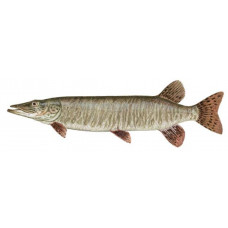Latin name
Esox masquinongy
Other names
Maskinonge, muskallonge, mascalonge, muskie, musky, ’lunge, silver muskellunge, Great Lakes muskellunge, Ohio muskellunge, Allegheny River muskellunge, spotted muskellunge, barred muskellunge, great muskellunge, great pike, blue pike, and so on. Occasionally, it is referred to as a “jack” in some areas.
Identification
The muskellunge has an arrow-shaped body, long and smooth. The single dorsal fin with soft rays is located very far back near the tail. The pelvic fins are relatively far back on the belly, about halfway between the pectoral fins and the tail, rather than directly under the pectoral fins. The mouth is large, with the maxillary bones reaching back to the center of the eyes, and is wide and full of teeth. The coloration and pattern of the muskellunge is very variable, but usually consists of dark markings on a brownish or greenish background. There are numerous dark vertical stripes that may look like vermiculations or spots, and sometimes there are no markings on the body. Muskellunge can be distinguished from other Esox species by their cheeks and gill covers, which are usually covered with scales only on the upper half. Another difference is the number of pores under the lower jaw. Muskellunge have 6 to 9 pores on each side (rarely 5 or 10 on one side only).
Distribution
The muskellunge is endemic to eastern North America. It inhabits the Great Lakes, Hudson Bay, and Mississippi River basins from southern Quebec to the North Red River in Manitoba, and extends south in the Appalachian Mountains to Georgia and west to Iowa. It has been widely introduced (including a hybrid version) into the Atlantic Coast drainages as far south as southern Virginia and elsewhere in the southern and western United States, although its representation in many of these areas is low.
Habitat
Muskellunge live in medium to large rivers and lakes of all sizes, although their preferred habitat is cool water with large and small pools or both deep and shallow areas. They can be found in waters as small as 75 acres or as large as Lake of the Woods, Ontario, Lake St. Clair, Michigan, or the St. Lawrence River. They rarely venture far from cover, preferring shallow water with abundant vegetation less than 40 feet deep, but will sometimes inhabit deep water with no vegetation but prey.
Size
Muskellunge are among the largest North American fish found exclusively in freshwater. The former all-tackle world record and current New York State record is a 69-pound, 15-ounce fish caught in the St. Lawrence River in 1957. Most muskellunge caught by anglers weigh between 7 and 15 pounds and are less than 40 inches long. Specimens over 20 pounds are not uncommon, but it is difficult to find fish over 30 pounds. They are known to live from 25 to 30 years, and many fish live 15 years, although the average life span is closer to 8 years.
Life history and Behavior
Muskies spawn in the spring in shallow, vegetated bays 1 to 3 feet deep. This occurs just after the ice melts when water temperatures range from 49° to 59°F. They disperse the fertilized eggs randomly. Their spawning usually occurs in areas where the two species coexist. Females grow larger than males at all ages and reach sexual maturity in 3-5 years.
Food and feeding habits
The muskie is a solitary fish that usually stays in the same place, lurking in dense weeds and waiting for prey. It may move from deep to shallow water to feed. Its diet is varied, with a preference for large rather than small fish, as it is well adapted to catching and swallowing fish of considerable size. Yellow perch, suckers, golden shiners, and walleye are its favorite foods, but it will also eat smallmouth bass and many other fish.
Reproduction
No information
| Classification | |
| Phylum | Chordata |
| Class | Actinopterygii |
| Squad | Esociformes |
| Family | Esocidae |
| Genus | Esox |
| Species | E. masquinongy |
| Features | |
| Conservation status | Least Concern |
| Habitat | Pelagic |
| Life span, years | 30 |
| Maximum body weight, kg | 30.5 |
| Maximum length, cm | 180 |
| Sailing speed, m/s | No information |
| Threat to people | No information |
| Way of eating | Predator |
Muskellunge
Tags: Muskellunge


